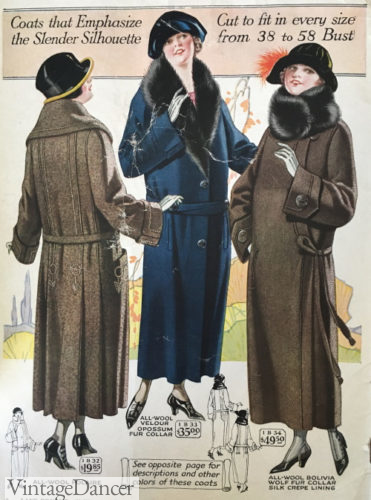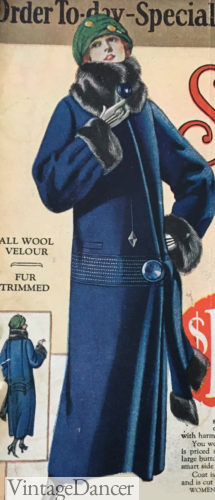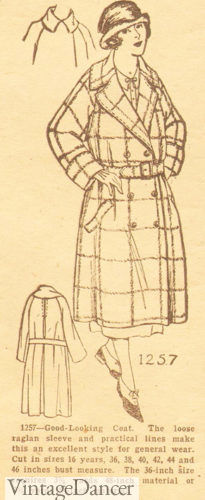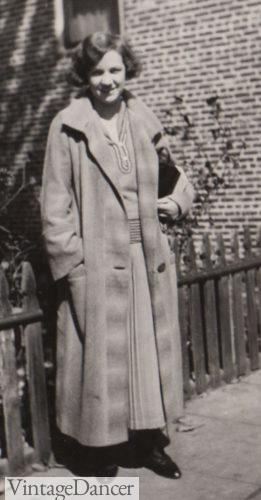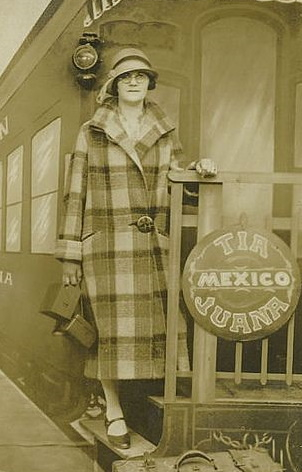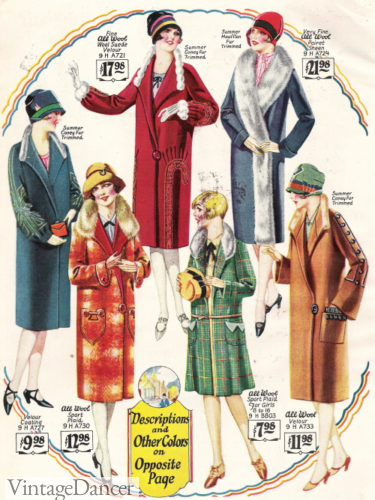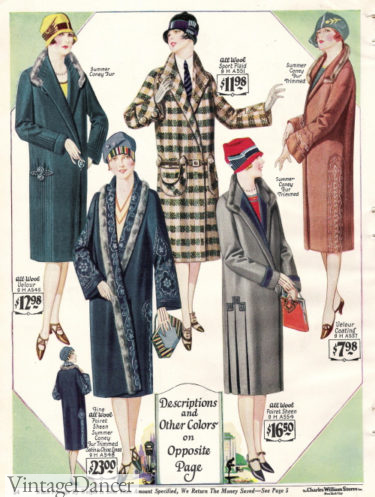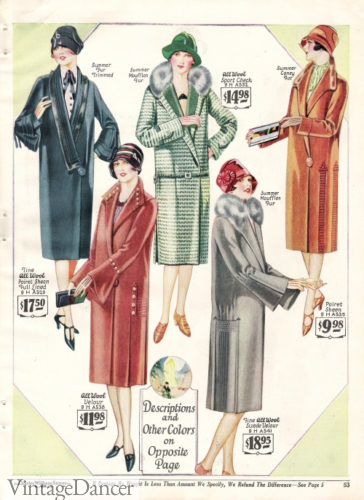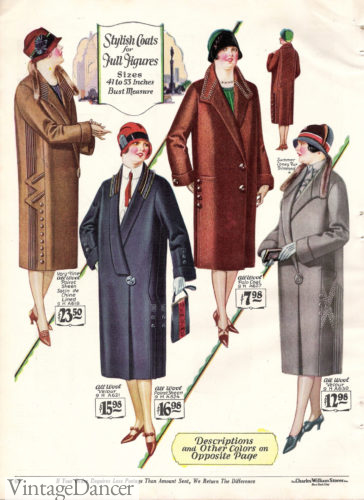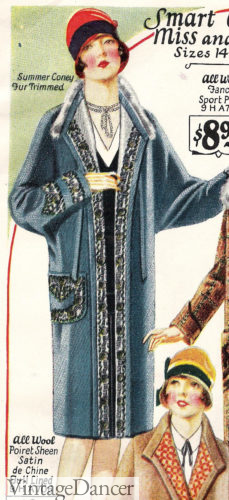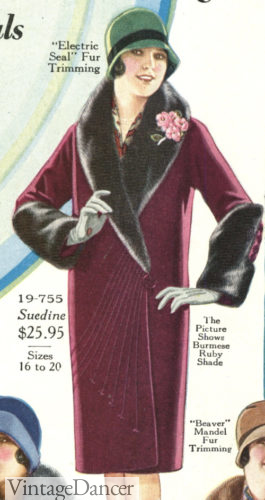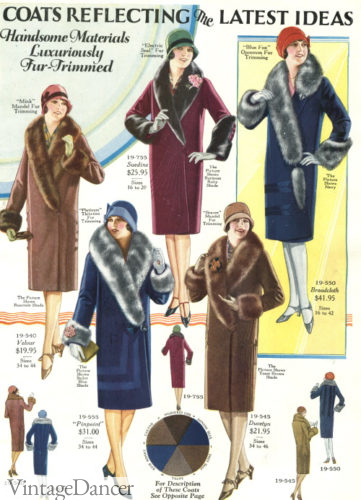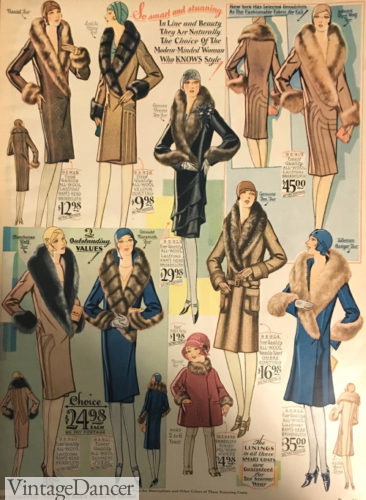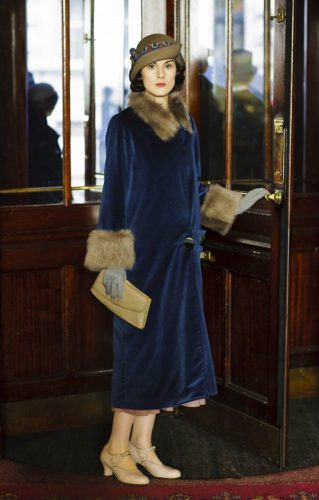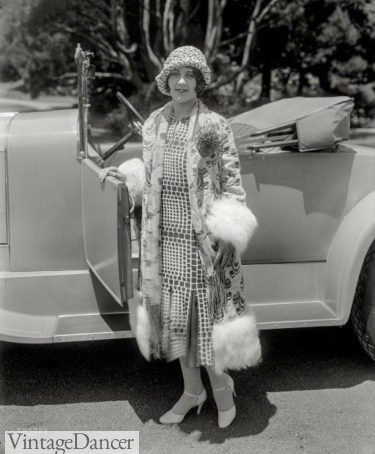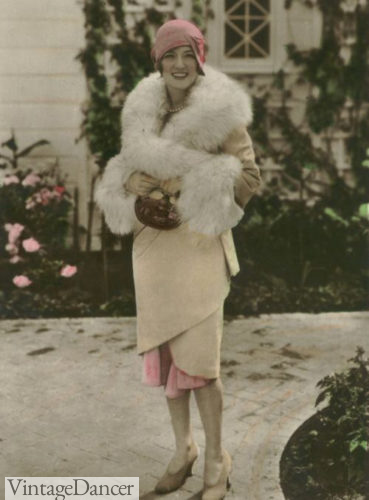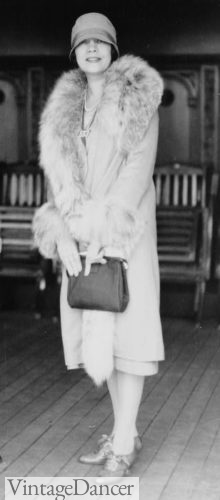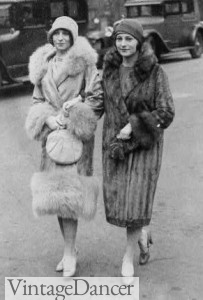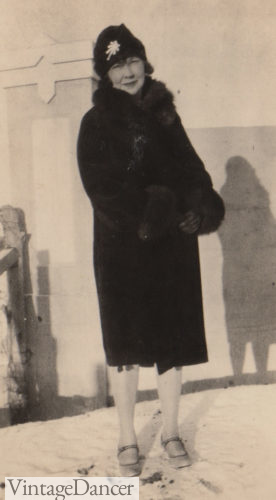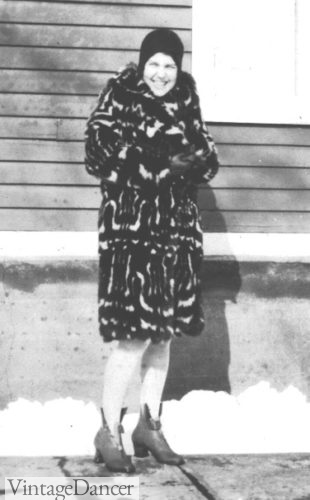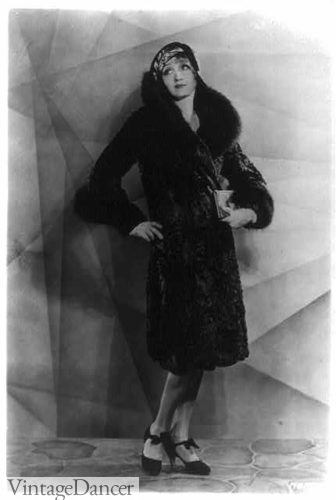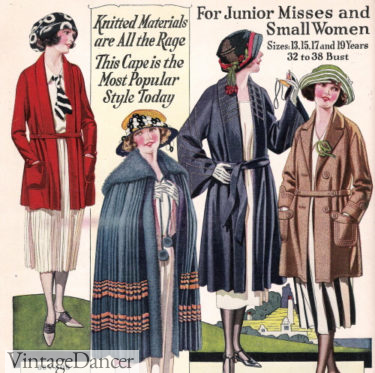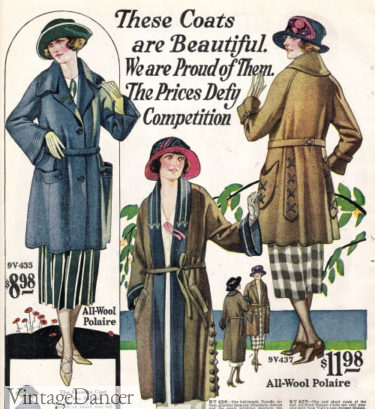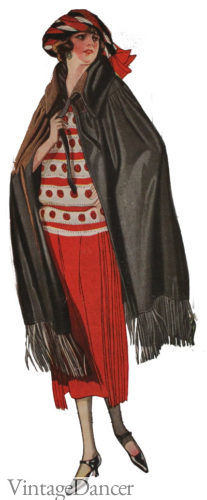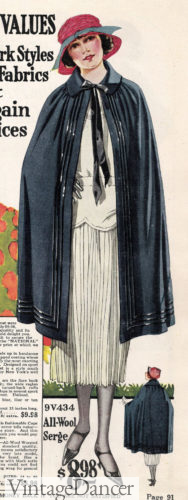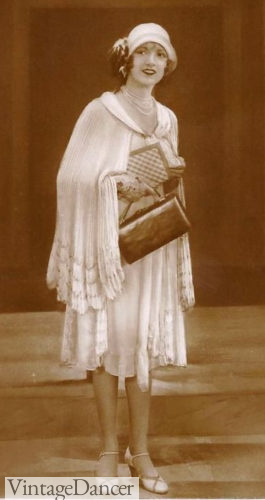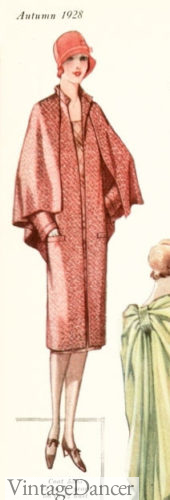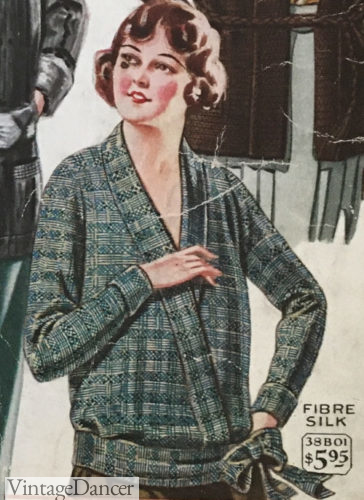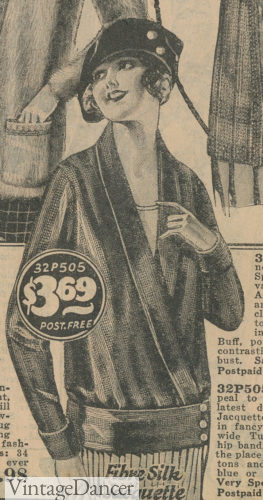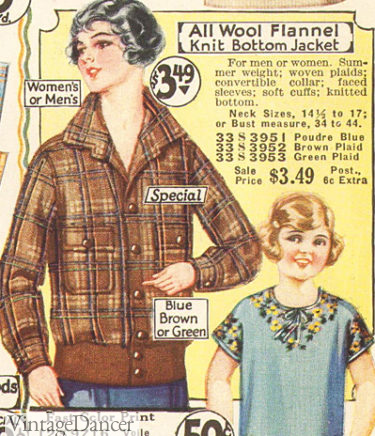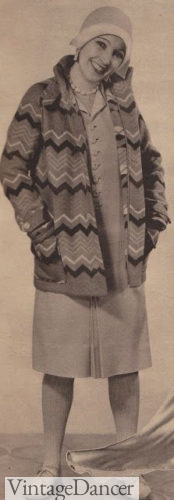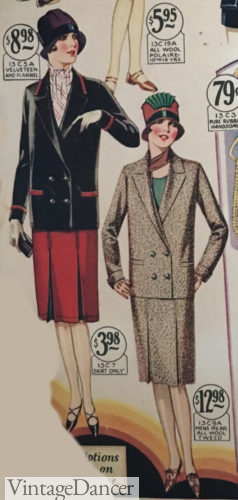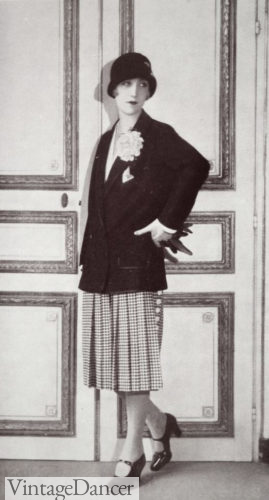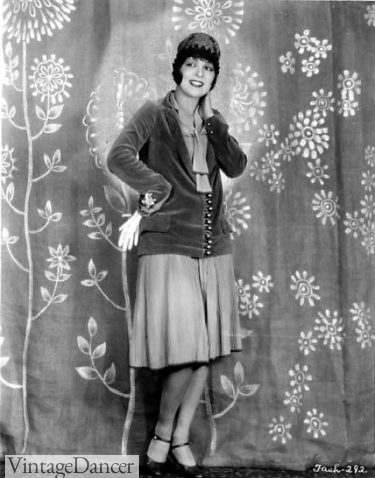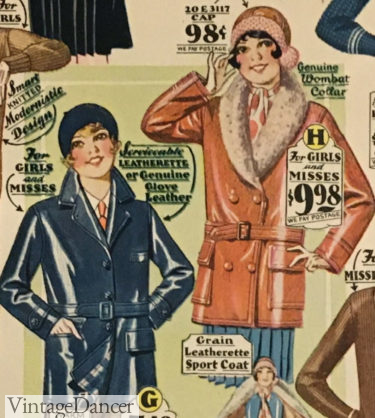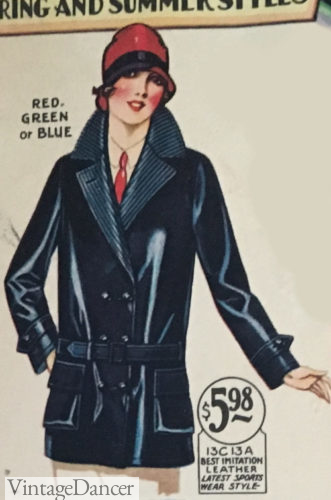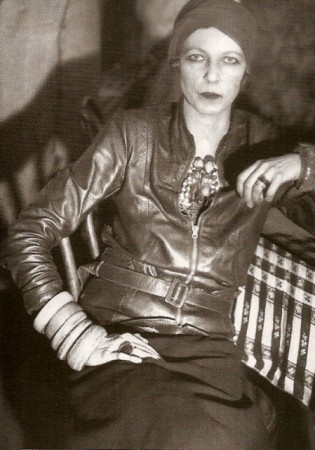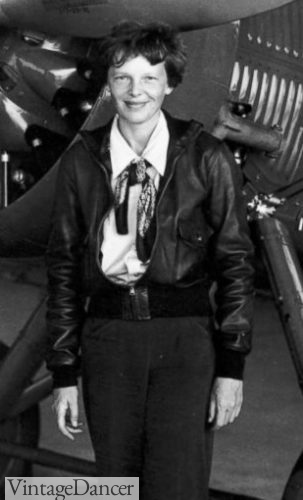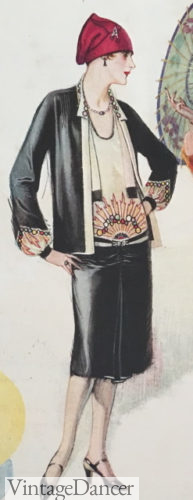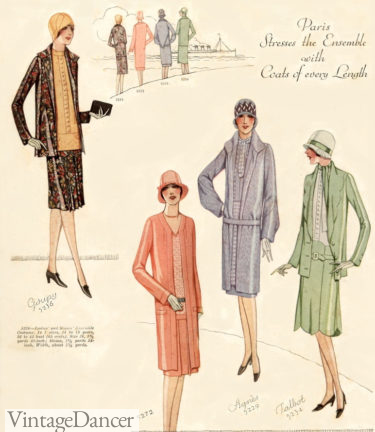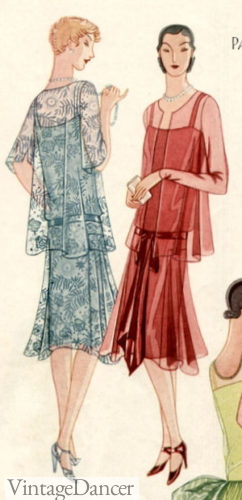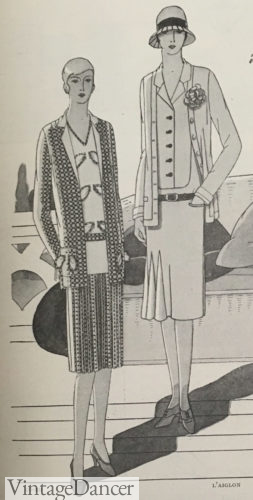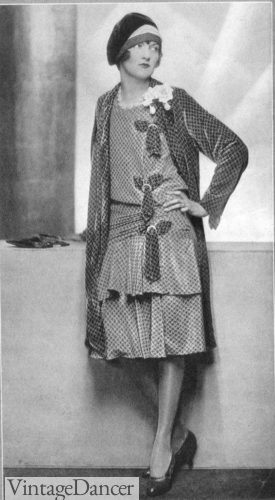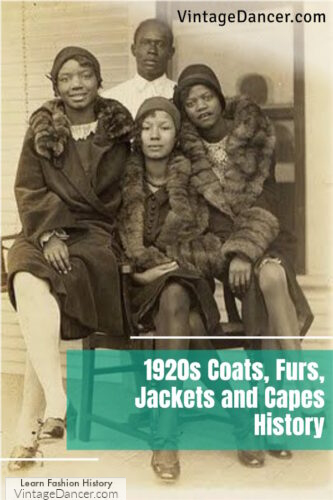
There’s nothing like the winter coats of the Jazz Age. Their curved shapes and large fur collars created a cocoon of warmth and style that has yet to be duplicated. Unlike the clothes underneath, coats and jackets of the 1920s tended to be quite simple. Even lighter weight spring and sport jackets were minimal in design, yet still a critical part of a woman’s casual ensemble.
The most iconic 1920s coat, the fur collar wrap coat, was a woman’s prized possession. Almost every woman owned one, and she wore it all year long.
Buy 1920s style coats and jackets or wrap, shawls and scarves.
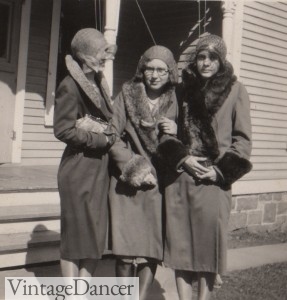
Ladies in Fur Trimmed Coats
1920s men, too, wore coats and jackets, and you can read about their history here.
1920s Winter Coats
The decade began with long wool velour overcoats that featured oversized details: big collars, big cuffs, large buttons, huge pockets, and matching belts. Some had detachable fur collars for extra warmth and luxury. Most of these coats came in neutral dark colors such as blue, brown, maroon, grey and hunter green.
The ample fit made women appear smaller underneath. They also provided room for the layering of warm clothes, an important matter in an age of indoor heating and frequent travel by foot, train or bus.
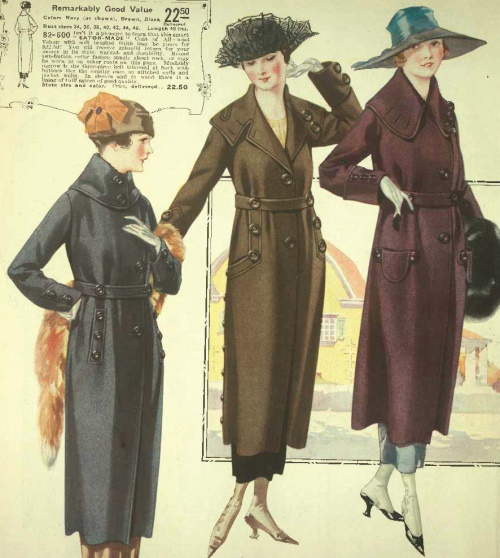
1920 Winter coats made of wool velour
Full belts that centered around the high waist were common in the early ’20s, as well as for collegiate or trench-style coats. The length hovered around mid-calf, showing a bit of skirt and tall lace-up or button-up boots below.
By 1923, wool coats had followed fashion trends for longer lengths, returning to a touch above the ankle. The wrap-over style, called surplice, was also emerging as a new fashionable style that would continue to dominate the 1920s. The surplice jacket was secured with a single large platter button over the right hip. Trim was subtle with contrast stitching in long straight lines or the more popular arrows. Sleeves were usually batwing or bell-shaped.
Overcoats that buttoned down the center now had belts that tied very loosely around the low waist/hip. This elongated silhouette was just what the decade needed to move forward into a new era of fashion.
- 1923, dropped belts and longer lengths in stout sizes
- 1923, new side wrap style coat with drop waist
A variation of the winter coat more often seen on girls, teens, and young women, was the collegiate coat. The coats were cut straight, double-breasted, and closed with two rows of six large buttons down the center. They were exactly like the men’s wool trench coats. Bright reds and blues were popular colors. The plaid coat was especially trendy in a single-breasted or wrap-over model.
- 1924 Collegiate style coat
- Plaid single breasted coat
- Plaid wrap overcoat
- 1924 Plaid single button coat
In 1925, the winter coat turned in new directions. Following the dresses, the coat length rose up to almost the knee. Single-breasted coats had a deep V neckline with a fold-out collar or high mushroom fur collar. Some coats had godet flares in the back, so they swung a bit as a woman walked. These, were short lived in the ’20s, but they came back in 1930s.
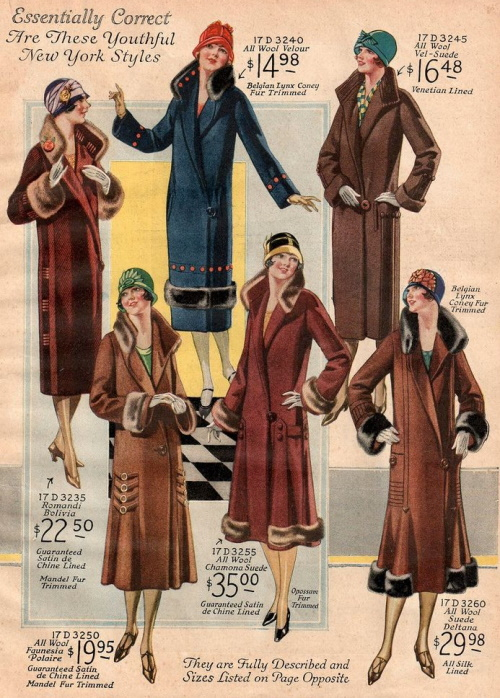
1925 Coats column shaped or with gored backs for some “swing.”
It was the straight shape in the wrap over or double-breasted front that was the trendiest for the second half of the decade. Compared to the early years, these coats were thin with narrow arms and a slightly tapered hem. They were made of wool, vicuna, velveteen plush, tweed, or wool velour.
Colors were brown, tan, rust, cranberry, grey, black, green, rose, or a medium blue. Patterns such as windowpane, plaid, checks and unique Art Deco inspired weaves added variety in spring.
The linings were made from crepe de chine, satin de chine, brocade, or other silks and blends in bright, cheerful colors and patterns.
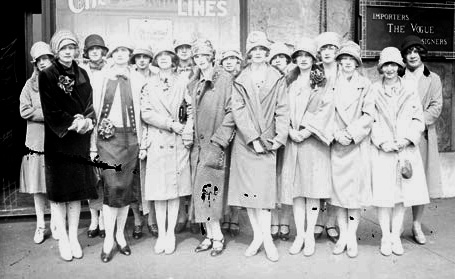
1926 coats, shorter and slimmer
Collars, pockets, sleeves, and sides were simply decorated. Cording, self-fabric trim, and matching embroidery in Eastern folk art style, Art Deco patterns, sunbursts, arrows, and diagonals added subtle details without detracting from the fine fur collars and cuffs. Belts were purely ornamental features that usually did not go all the way around the coat.
- 1927 young miss coats
- 1927 wrap coats
- 1927 wool coats for spring
- 1927 coats for stout figures
- 1927 Russian inspired embroidery on the lapels and pockets
- 1928, matching cording in a sunburst pattern explodes form the button towards the hem
Fur trim on the upper collar or a full fur shawl collar were both popular throughout the decade, but even more so in the later years. Fur was worn in winter and spring in a variety of colors and thicknesses. The affordability of faux furs and cheaper real furs dyed to look expensive made every woman capable of owning a fur collar coat.
- 1928 fur collar winter coats
- 1929 fur collar coats
- From Downton Abbey, season 5, set in 1924 – A velvet coat with fur cuffs and collar
- 1925 Ermine fur cuffs and hemline
- Marion Davies, actress, Ziegfeld Girl, in a fur collar wrap
- 1920s fur collar coat
1920s Fur Coats
A fur coat was the ideal winter coat for very cold climates and wealthy women in the cities. Furs were created from sable, mink, caracal, beaver, Hudson seal, civet, mole, squirrel, dyed rabbit, Manchurian wolf dog, marmot, and nutria. Coats came in full-lengths and shorter jacket lengths.
- 1927 All Fur Coats and Matching Accessories!
- Late 20s, black seal fur coat
- Skunk fur (?) coat
- Hedda Hopper, 1929, plush fur coat with fur collar and cuffs
Popular fur trim included mink, possum, raccoon, seal, fox, sable, and beaver for the upper classes. Middle classes may have chosen the cheaper weasel, squirrel, skunk, chinchilla, wombat, marten or mole. Some cheap furs such as rabbit’s fur (coney) were dyed to look like the more expensive fox and seal furs.
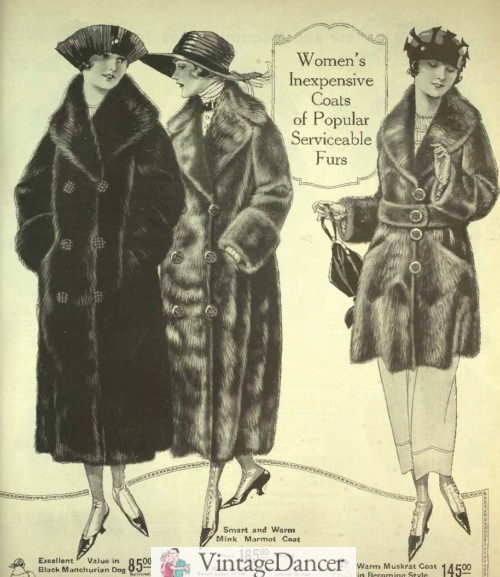
1920 cheap fur coats – wolf-dog, mink, and muskrat
There were also fur stoles, fur scarves, fur muffs, fur capelets, and detachable fur collars that could be layered over a plain coat or dress. Fur stoles and shawls make popular evening accessories today although not entirely accurate until the end of the decade.
Learn more about shawls, fur and scarves as accessories in the 1920s.
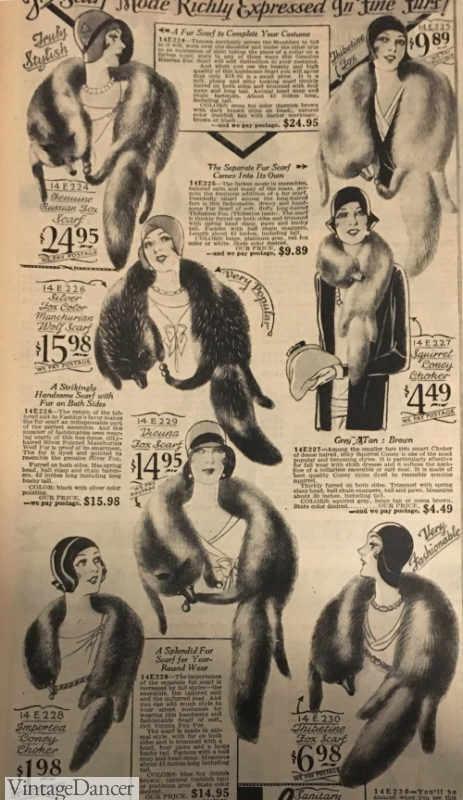
1929 fox fur stoles and scarves
If real fur was out of price range, there were synthetic furs, often called Siberian fur cloth, that resembled the real thing. The most favored furs had long, soft hairs. Short, thick, soft, and fluffy furs were also ideal in the later years.
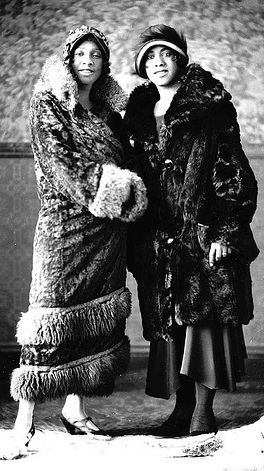
Full length fur coats
Coat cuffs were typically deep bands of matching fur and sometimes even longer gauntlet cuffs. Those on a budget skipped the fur trim altogether and simply turned back the wool cuffs to show off the silk or satin lining for a spot of color.
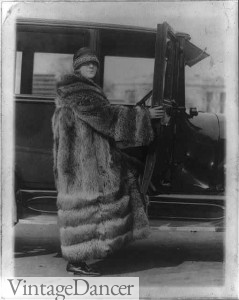
Raccoon Coat- early 1920s
One trend for both men and women college students were full length raccoon coats. Raccoon was a cheaper fur, making it slightly more affordable for students. To own one still meant she came from money and that she may have owned a Model T car or at least enjoyed riding in them. Model T’s were very cold to ride in in the winter.
Long fur coats were the perfect outerwear for driving in cars or watching football games. Every student wanted a raccoon coat, including the women, who may have been less likely to be drivers but were no less eager to show off their families’ wealth.
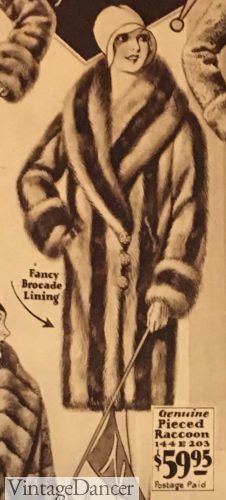
1929 pieced raccoon coat
1920s Ladies’ Raincoats
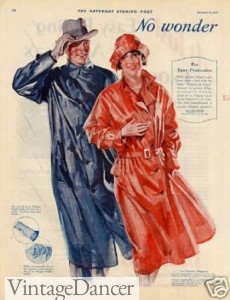
1920s Rain Coats Ad
For rainy weather, some women followed the men’s lead and wore a gabardine trench coat, although that became more popular in the 1930s. Of course, the purpose of the raincoat is to keep the wearer warm and dry, so materials tended to be oilskin or other rubber-coated cotton fabrics.
A woman’s raincoat was often a brighter color such as yellow, red, or blue. These bright colors also made it easier for drivers to see women walking in heavy rain.
Mature women sometimes preferred the rain cape, which fit like a poncho and had slits on either side for the arms. This was a common raincoat for children as well.
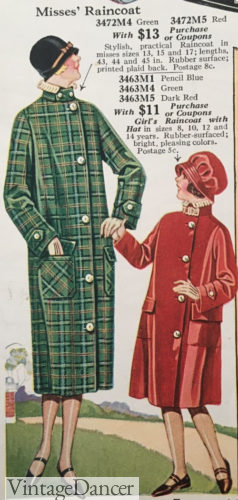
1926 green plaid raincoat and girls red
Whatever style of raincoat a woman chose, a rain hat was necessary. Some women could get by with a wool cloche hat but heavier rain required a rain cap, which looked like an old mop cap with a curved brim. Even in the ’20s, sometimes function took precedence over fashion.
Read more about 1920s raincoats and hats here.
1920s Spring Coats
In warmer weather, heavy overcoats became too much. Yet due to lack of heating, warm coats were still often needed in spring and summer. Spring coats were made of lighter wool, velour, polaire, flannel, jersey, or cotton knits with an open front held loosely by a tie belt. They were usually considered “sportswear” rather than dressy coats, although women wore them with all kinds of outfits.
In the early twenties, sports coats could be neutral winter colors or brighter sporty colors such as red, yellow, green or blue. Most sport coats were shorter, extending down to the mid-thigh. The sweater-coat was knitted like a sweater but shaped in the style of a coat with a pointed collar, cuffs, and buttons. Read more about 1920s sweaters here.
- 1922 sport coats, capes and a cardigan sweater
- 1922 spring coats, shorter lengths
The spring cape was another coat found in the early 1920s that was worn open with only a tie around the neck. The cape was more often a fancy evening wrap, but as a day coat its elegance hinted that the wearer was fashion-forward. Cape-coats could also have armholes, a wrap-over front that tied with a belt, and a cape back that draped over the shoulders. Casual capes could be knitted, trimmed with fringe, made of velvet (to double as an evening cape), or fringe-trimmed wool velour. By the late 1920s many spring coats featured short cape effects, as did dresses.
Coat alternatives for all seasons were the cape, shawl, scarf, opera coat or silk scarf coat. Read about them here.
- 1922 fringe cape
- 1922 velour cape
- 1922 cape coat with arm slits
- 1922 knit cape
- Mid 20s matching dress and cape
- 1928 coat with cape back
1920s Spring Sport Jackets
While coats were usually long, jackets were short (waist to hip length) and made of knits, wool flannel, tweed, silk, or other medium-weight cloths. There were few styles available in the 1920s, because sweaters were preferred over jackets until the end of the decade.
These 1923-1924 wrap jackets were essentially a blouse worn over a slip, chemise or light dress. It would come back into fashion a few years later as the blazer jacket.
- 1923 silk wrap jacket
- 1924 silk wrap jacket
Mackinaw jackets for women were the sportiest jackets in the mid to late 1920s. Worn with knicker pants or casual skirts, they were nearly identical to men’s jackets with ribbing at the cuffs and waistband, a contrasting collar, and buttons that were usually made in plaid wool flannel.
- 1926 Mackinaw style jacket
- Chevron stripe sweater coat (Hungary)
Windbreaker jackets were similar but with knitted bodies and a knitted bottom band and cuffs. Most sports jackets and sweater-coats featured fancy patterns of chevron, plaid, checks, zig-zags, and Fair Isle prints in clashing colors – blue and orange, brown and green, red and yellow, or maroon and blue to name a few.
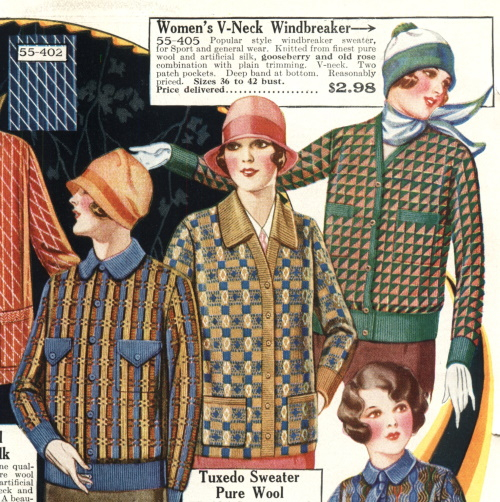
R and L, 1928 windbreaker jackets, cardigan sweater in the center.
1920s Summer Blazers
In the late 1920s, the blazer jacket came flying back into fashion. Previously seen in the late 1910s, the striped tennis blazer or beach jacket could be worn with nearly any skirt and blouse combination or over a sporty all-in-one dress. Popular colors were red and white, blue and white, or green and white. Vertical stripes were a common pattern.
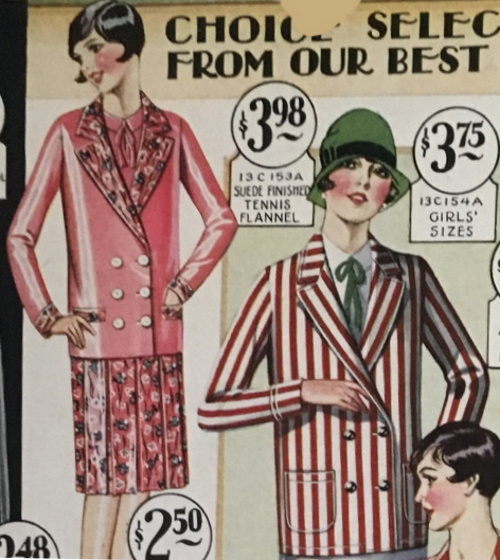
1928 striped tennis blazer and floral trim pink blazer suit
This blazer style became so popular that it became the new suit jacket, made in either in a matching or contrasting color. Matching blazer jackets were sold with some spring dresses around 1928-1929. In the 1930s, the woman’s suit embraced all types of short jackets and blazers in the new man-tailored fashion.
The black silk, brushed flannel, or velvet blazer was especially popular with movie stars who wore them over plain dresses or as a mix and match set with a skirt and blouse.
- 1928 coordinated black and red blazer with skirt and all matching tweed suit
- 1928 black blazer and skirt set
- 1927 blazer jacket with flower boutineer and check skirt
- Clara Bow wears a velvet blazer over a plain dress
1920s Leather Jackets
Aviator Amelia Earheart and other pioneering adventurous women were inspiring a new wave of women’s fashion, also borrowed from menswear. The leather aviator jacket was one of those adoptions. In its basic form, it was a brown leather jacket with a waist tie belt and large pockets. As an imitation leather blazer, the jacket was slimmed down to more feminine proportions and offered in vibrant colors such as red, green or blue. Suede and buckskin dyed in muted colors were also offered in other menswear-inspired cuts.
- 1929 girls’ or misses imitation leather colored jackets
- 1928 imitation leather jacket
- Nancy Cunard, 1928, in a belted leather jacket
- Amelia Earhart – leather flight jacket
1920s Dress Jackets
If you watched Downton Abbey or Miss Fisher’s Murder Mysteries, you may have fallen in love with many of the lightweight coats and jackets the ladies wore. These spring coats were usually sold as a set with a matching dress — a luxury only the rich could afford. Some women mixed and matched a coat from one dress with a dress from another set, although the norm was always to wear a matching set. The dress and jacket set became increasingly popular and affordable towards the end of the decade.
The late twenties, dresses came with coordinating jackets. Most jackets were long and open but some could be buttoned up like a cardigan sweater. The materials were light silks, rayons, or sheers. The Bolero jacket also came into style at this time.
- 1927 dress with matching jacket (love the Art Deco design)
- 1928 spring dress and jacket sets
- 1929 sheer jackets and dresses
- 1928 spring dresses with jackets
- 1928 polka dot dress with reverse jacket
- 1928 ruffled edge bolero jacket
Continue reading about 1920s evening coats, shawls, furs and wraps here.
Finding a 1920s style coat is incredibly difficult. Wraps and shawls are much easier, but winter coats are few and far between. We keep an eye out for cocoon-shaped coats, fur collar coats, and embroidered Russian style coats, as well as vintage coats from the 1950s that had similar shapes.
Shop 1920s Style Coats and vintage 1920s coats
Find a 1920s coat sewing pattern here.
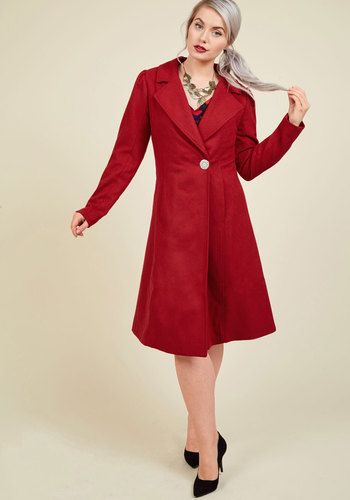
With it’s wide lapels and single button closing, this coat from Modcloth is perfect for 1920s styles.
Debbie Sessions has been teaching fashion history and helping people dress for vintage themed events since 2009. She has turned a hobby into VintageDancer.com with hundreds of well researched articles and hand picked links to vintage inspired clothing online. She aims to make dressing accurately (or not) an affordable option for all. Oh, and she dances too.
